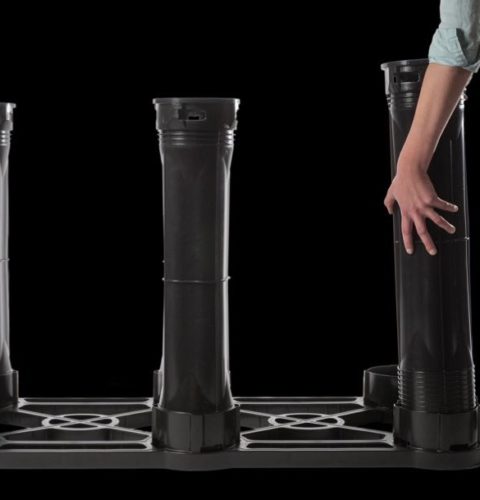

Below are some of the most frequently asked questions and answers. Feel free to reach out to us directly if your question isn’t answered below.
Yes. Silva Cells are a modular pavement support system that can be designed to allow the space under paving to function equivalent to bioretention. Silva Cell bioretention facilities have been demonstrated to achieve similar water quality outcomes to typical bioretention. The system can also be configured similarly to other stormwater best management practices (BMPs), including systems similar to underground vaults or chambers, to provide storage for infiltration or flow detention.
No, Silva Cells are a modular pavement support system which can be used to install bioretention under the pavement. An engineer must size the system and select or design the components of the underground bioretention system (e.g. media) that will be used with the Silva Cell system to achieve equivalent performance to bioretention. This fact sheet describes how an engineer can design a bioretention equivalent system below pavement using Silva Cells.
In order to serve as green infrastructure for stormwater management, key elements include: a stormwater inlet system, pretreatment system (where needed), flow distribution system, Silva Cell modules, appropriate tree(s), and a flow collection system (e.g., underdrain, where needed) with a connection to an appropriate discharge point.
Silva Cells have been implemented in municipalities across the United States, Canada, and the United Kingdom. Silva Cells have been approved as a treatment technology by several agencies, often as an equivalent to other stormwater management approaches.
In general, the soil mix used for a bioretention- like application should be consistent with local bioretention or biotreatment soil mix requirements. This Fact Sheet provides suggested soil mixes and properties for locations where local bioretention soil mix requirements have not been adopted.
Silva Cells support a tree by providing sufficient soil volume for the tree roots to expand within the modular system (below the pavement) and by reducing soil compaction.
Silva Cells require minimal maintenance. The inlet/outlet structures, distribution pipes, and underdrain pipes require periodic cleanout. The trees in the system will require annual landscape maintenance and irrigation.
Pretreatment should be installed per the local requirements for bioretention facilities. A range of approaches may be appropriate. Additional information is provided in the “Inlet Design” section.
There are multiple possible configurations for the inlet design, including a catch basin inlet connected to a flow distribution pipe, percolation through pervious pavement above the Silva Cells, inlet pipes from roof leaders, or inflow from pretreatment devices. Additional details and information are provided in the “Inlet Design” section.
Though the area taken up by the tree does provide biotreatment and evapotranspiration benefits, because the soil directly adjacent to the tree typically does not consist of bioretention media formulated similar to locally applicable standards (when installed), the area of the tree root ball at installation is often not included in treatment area calculations. Inclusion of this area may be allowed by certain jurisdictions.
Yes, our modules can be moved and oriented to accommodate most utilities, footings, and other obstacles. Integration with utilities is by no means a barrier to using Silva Cells! Silva Cells are designed to be completely structurally independent, meaning it is not necessary for them to be in a linked matrix for support. The space between Silva cells are adjustable and when combined with our large module size (which offers significantly more room for routing utilities through the cells), makes going around, over and under utilities simple.
When utilities are too large to be run though the soil within the Silva Cells and aggregate gaps may be used or a shorter module can be used to “step” over or under the utility while maintaining a connected soil volume. DeepRoot’s technical team is always happy to help you design your system around exiting or proposed utilities and can provide completed shop drawings for your project. We’ve seen it all, from the smallest footing to the largest duct bank.
We do not advise cutting or modifying individual Silva Cells in any way. Silva Cells are a structural element and altering them leads to an unknown redistribution of force on the unit. Without testing that simulates the exact field conditions for each project, it’s very difficult to conclusively know how cutting or otherwise modifying a Silva Cell might impact the remaining portions of the structure. The good news is that the need to cut a Silva Cell should not arise. Due to the modularity and structural features listed above, the cells can be easily arranged around any obstacle.
Silva Cells can be used on sites where existing trees need additional soil volume. First, a local arborist should evaluate the trees and determine if root pruning is an option and how much the roots can be cut back without impacting the health of the trees. The Silva Cells can then be installed as close to the tree as the root pruning will allow. If possible, it is beneficial to keep any supporting roots that can pass through the new Silva Cell system similar to how you would build our system around a conduit.
It is important to understand that the tree pit for a retrofit will be much larger than a tree pit for a newly planted tree due to the extent of the tree’s roots. Tree openings need to be sized proportionally to the size of the root mass.
Using Silva Cells for a retrofit is often more costly than a traditional installation. Excavation costs are generally higher as the roots must be treated carefully and hand digging will likely be required in some areas. However, when working with valuable or historically significant trees, this extra effort is worthwhile. Learn more here.
The purpose of the geogrid is to separate the compacted backfill from the uncompacted planting soil within the Silva Cells and provide support in areas of transition. Geogrid offers the amount of strength needed to hold back backfill and other soils from the soft, uncompacted soil filling the system. While geotextile could also be used in this way, tree roots are unable to pass through geotextile material, thus forever limiting the tree to the space provided in the Silva Cell system. Geogrid allows roots to exit the Silva Cell system and expand into the surrounding area over time. In short, either geogrid or geotextile may be used around the perimeter of the Silva Cell system but only geogrid will allow the roots to reach beyond the system as the tree grows.
Root Barrier product has vertical elements that direct tree roots down and away from hardscapes, preventing costly root damage while preserving the health and beauty of mature trees. When used with the Silva Cell system, a root barrier directs the roots down and into the soil within the Silva Cells. An installation without a root barrier risks the roots making their way into the pavement profile, causing damage to the pavement and/or aggregate base layer. By directing the roots into the soil within the Silva Cells, not only is pavement damage avoided but the tree is able to access the nutrients and water provided in the soil. DeepRoot’s Root Barrier has ground lock anchors that hold the root barrier into the soil and prevents ground movement from pushing the root barrier back up out of the ground. Using a root barrier on your project is a simple way to ensure your trees find soil and resources without damaging surrounding paved areas.
Underdrains are necessary in applications where water is artificially introduced into the system. If your project uses permeable pavement, has surface run off piped into to the system, directs water to the tree openings via curb cuts etc., and underdrain should be used. In northern climates where road salt is used, having an underdrain helps the spring rain flush excess salts out more efficiently.
When it comes to non-permeable applications where the only water entering the system (other than irrigation) is what lands in the tree openings, having undrains is based on factors like risk of oversaturation, added cost of installation, and availability of a suitable outlet. If you have questions about whether your project needs an underdrain, contact us!
From our perspective, yes. Any tree can be used. Silva Cells have been used successfully with many tree species from live oaks to palm trees. Any tree well suited to the location it will be planted may be used with Silva Cells.
Because we install projects all over the world, we defer to local designers and arborists to determine appropriate species for each project. Some communities also have a species diversification plan that determines what species of trees are acceptable to use in the area. We are ready to assist you with your project, please email us at [email protected] to connect with a DeepRoot team member today.


Request a Quote [email protected]
Tel: 415 781 9700
Toll Free: 800 458 7668
Toll Free: 800 277 7668
Fax: 415 781 0191

